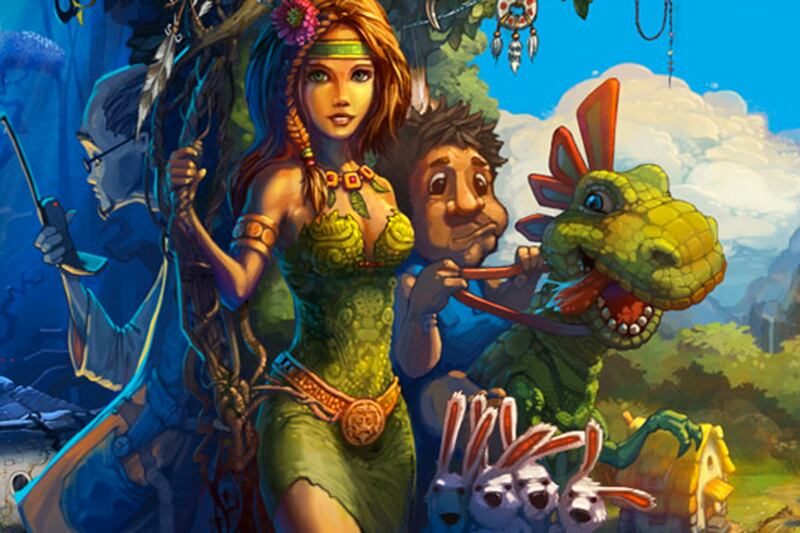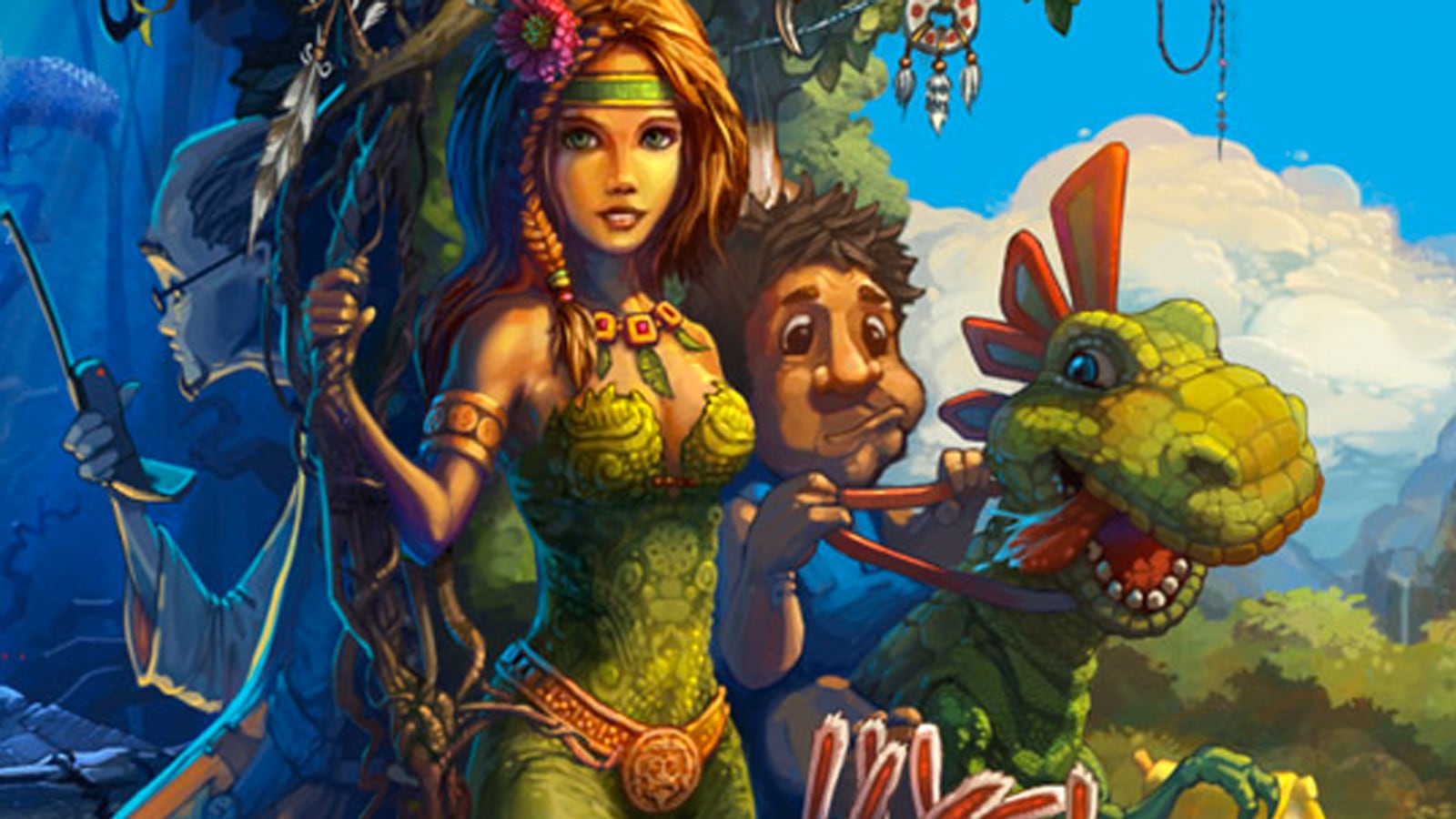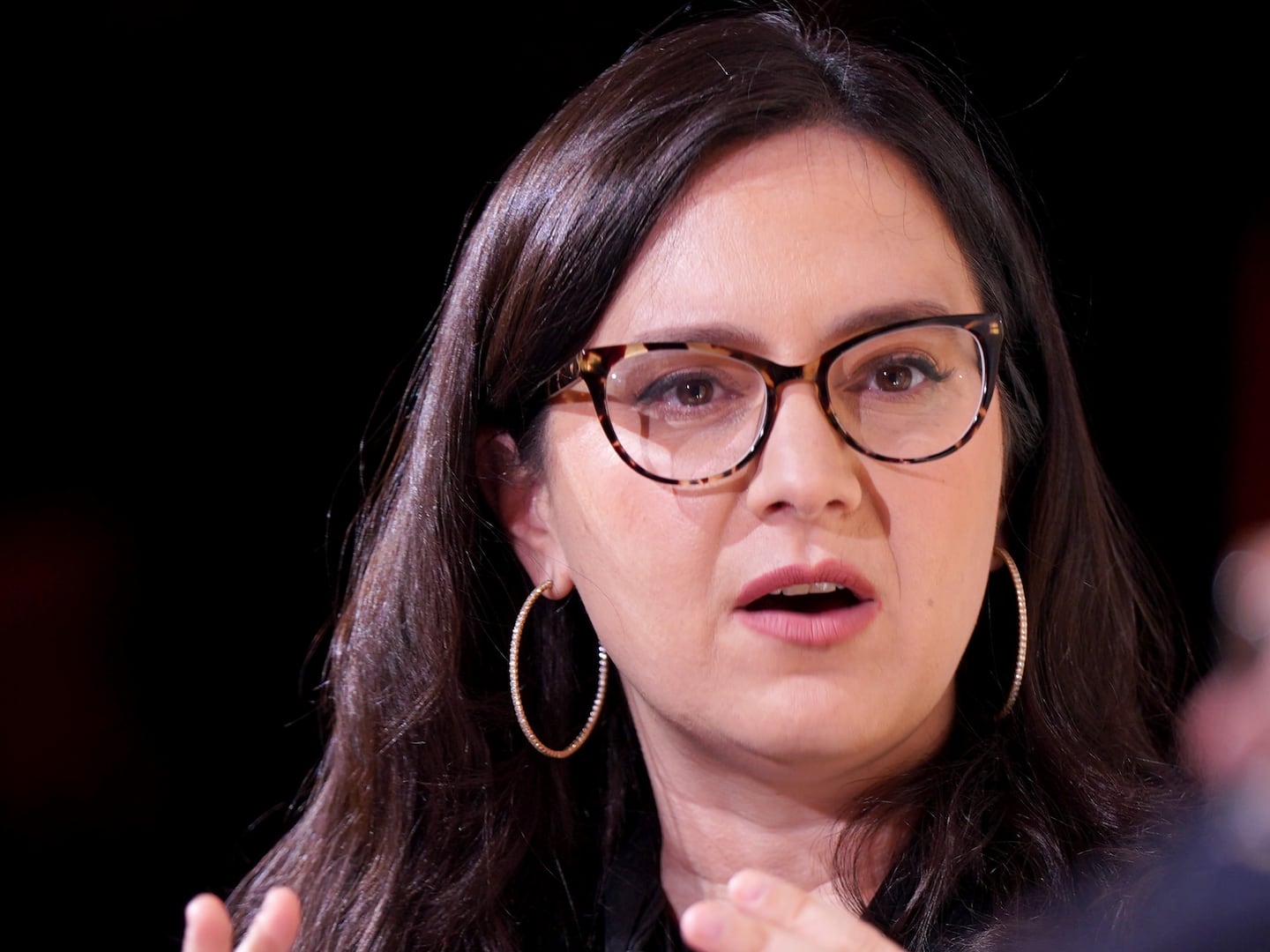“Greetings, stranger! The Great Spirits have promised to send this tribe a new chief! Could it be you?” Those are the opening lines to Game Insight’s city-building behemoth, The Tribez. The iOS/Android/Facebook game, which tasks players with building up an empire in an ancient landscape, has been a huge success. And it often trends on Twitter.

On the screen is a small but densely packed section of land. There’s a pool of water with a futuristic submersible next to a wooden canoe, a cave with some glowing red eyes peeking out, a house, some trees, and a lazy looking man.
“Tap to continue,” the game commands.
“I am Aurora, daughter of Summer Wind, chief of the neighboring tribe. I am tasked with verifying that you are indeed the one sent to us by the Spirits!”
If the submersible wasn’t enough of a tip that this isn’t just some simple prehistoric God game, another speech bubble pops up, beside it a man with crazy hair and a lab coat. “Come in, come in, this is the professor. Are you on location? Excellent, then the crossing was successful! You should go ahead and make nice with the locals. I’m sure they’ll be very useful.”
Within ten seconds, I’ve already completed a quest, earning 20 gold and 5 experience points. The gameplay is simple (tap things to interact with them), and it only takes a few minutes to really grasp the basics, but a lot can be done with simple mechanics, and The Tribez has a surprising amount of depth. It’s a game that’s worth telling people about.
Initially released for the iPad in April 2012 (only nine months after development began),The Tribez was ported to the iPhone the following month. In October, it made its way over to Android. In March 2013, it made its way over the Amazon Appstore and then onto Facebook in September. Since then, it has been downloaded over 9 million times: 4.1 million times on iOS (more than half of those being the tablet version), 3 million times from the Google Play store, 1.6 million times on Facebook, and 320,000 times on other platforms (such as the aforementioned Amazon Appstore and the SK Planet’s T-Store in South Korea).
And publisher Game Insight wants everyone to play. After the tutorial ends and another quest is completed, something new appears on the screen: two share boxes, one for Twitter and the other for Facebook. Letting friends and followers know about quest completions will give in-game rewards, which is a pretty serious incentive to spam feeds with updates. Soon, two new quests are added to the queue, each with a 24-hour timer, and both asking me to connect my Twitter and Facebook accounts.
***
This is the rise of in-game socialization. Over the years, Facebook feeds have been filled by messages from games such as Mafia Wars and Farmville. But these updates are no longer just a part of games found on Facebook; they have made their way outside this ecosystem. According to the The Tribez’s Chief Producer, Leonid Sirotin, “These so-called ‘viral’ elements are present, in one form or another, in every modern game.” And while that’s a slight exaggeration, different types of social integration have been increasingly prevalent in recent years, and as we discussed some time ago, the next generation of home consoles will take that even further (as with the “Share” button on the PlayStation 4’s controller).
“We want to empower those users who desire to be more social and more in touch with other players in the game community. Such social networks as Facebook and Twitter fit these purposes,” Sirotin says. “It is always up to the user whether to use them or not.”
I did not connect my accounts, and fortunately the game respected that decision. Once I unchecked the sharing boxes at the bottom of the quest completion pop-up, they stayed unchecked. But there’s a cost to my isolation: I lose a pretty large number of gems by doing so, because optional or not, the game really wants players to share. “Gems” are one of the two forms of in-game currency, alongside generic “gold,” and many items can only be bought with one or the other (although some can be bought with either). Gems are far scarcer, but anytime a player is running low, they can always open their wallet and buy some.
This is the new model, “free-to-play” or “freemium,” that is so popular on mobile devices and has been working its way onto PCs and traditional console platforms as well. This dual-currency system is typical in this sort of game. Sirotin explains: “The Tribez has two types of in-game currency: one that can be earned by playing the game, and another that is granted for outstanding results or can be bought via in-app purchase. This makes playing more interesting and helps us motivate players in various ways.” According to him, every one of the company’s games is free-to-play, “and we don’t have plans to change that.”
Soon after completing the tutorial, I happened upon a “Great Spirit’s Chest,” a 72-hour long bonus that promises to give me three times the amount of in-game gold or gems for the same amount of actual money. Such bonuses or the occasional one-time deals pop up constantly (especially earlier in the game), even when I’m not connected to the Internet and can’t actually make purchases. On Android, prices for in-game currency ranges from $2.99 for 1,500 gold or 30 gems to $99.99 for 50,000 gold or 1,000 gems (pre-bonus). On iOS, it’s a little different: the most frequent in-app purchase from the iTunes App Store is 20 gems for $1.99. The cost per gem is the same, but the increments are different.
Despite the naggings and notifications, spending actual money isn’t required. “It’s possible to play and complete the game, experiencing all the content, absolutely free of charge. This is the main advantage of the free-to-play monetization model. Sure, we offer players the option to purchase premium content, but it has an indirect influence on the game that doesn’t change or unlock any additional content,” Sirotin says.
The Tribez’s real trick isn’t the use of short-lived bonuses or one-time deals to convince people to pay; it’s the fact that, like many similar games, players have to wait while things happen. Harvesting corn? Wait an hour… or pay four gems to speed the process up. Building huts or clearing rock piles? Same deal, different waits/costs. For players who pay for gems or share their progress with others, occasionally speeding up projects isn’t a problem, but those other players (myself included) just have to wait.
The Tribez is meant to be played in short bursts, and in-game actions continue when the player isn’t watching it, so players can check in every few hours (or days) to reap the fruits of that labor, perhaps expanding the map a bit, and then setting up some minions building or harvesting or doing something that will take some time before shutting it off and doing something else. Sirotin says that the average game session lasts a little over six minutes, and my own experience has been similar. Since I started playing, I have harvested while walking to the train station, built while on the train, and even during periodic breaks at work pulled out my Nexus 7 to collect gold. And once that’s been done, back into my bag it goes. But just in case I would ever forget about doing any of that, whenever I open my tablet, the notification pane lets me know that “Gold is ready to be collected, chief.”
***
Sirotin and his team of 40+ of passionate game developers (all of whom play games themselves) are based in Moscow, Russia. When asked about Russian game development, Sirotin says, “We have a very strong educational base for programming, and many talented people. This means that as a result, we have many talented programmers and artists, and that’s what Russia is famous for. As a result, there are many companies in Russia that develop games for mobile and social platforms that are successful not only in Russia, but also all over the world.”
And those who play Tribez definitely seem to enjoy it, if the average user rating of 4.5/5 on both the App Store and Google Play Stores is any indication. (One in-game quest asks that the player rate the game, saying, “I’m confident that you love our game! Write a positive 5-star review!” Interestingly, there is no obvious reward for doing so.) Have all of these downloads led to revenue for the company? No, but though Sirotin won’t tell me how many players had gone for premium options, he reveals that the game has thus far made around $27 million in gross revenue. “We’re extremely satisfied with how well the game has done so far,” he says, noting that of the 31 games listed Game Insight’s mobile portfolio, The Tribez is in the top six.
Not too shabby.
According to Sirotin, “Compared to other Russian companies, Game Insight structured a bit differently. We have 17 studios incorporated into our structure, and the overall number of employees exceeds 800.” But these studios aren’t just “Game Insight Moscow 2” or “Game Insight Hong Kong.” “It is essential to note that all studios develop games by themselves. In many respects, they feel and act like separate studios—they have their own offices, logo, culture, and approach,” Sirotin says.
The actual developer of The Tribez, Divo Games, partnered with Game Insight for The Tribez’s production, but is still its own entity. Before joining Game Insight, The Tribez they primarily designed shareware games for PCs, including a game called Jack of all Tribes, which is aesthetically similar to The Tribez but is a one-time purchase and thus has differently structured play. Sirotin was quick to add that even the visual similarities have their limits, though. “Though they may have a similar art style… the graphics are actually different and much better.” There’s also the name difference, and I had to ask why the game’s name name ended with a “z.”
“To be honest, one of the main reasons we went with this name was to avoid any confusion between our game and all the games that contain “Tribes” in the title.” A quick glance at both the App Store and the Google Play store show dozens of hits for “Tribes,” so it makes sense, although it’s worth noting that The Tribez is the first for both. “Also, we think our name sounds cool,” he adds.
Sirotin says that the average player sticks with The Tribez for between 60 and 80 days, although “plenty” who have been playing from the beginning are still going. And Divo Games, which has been working on the game from the beginning, continues to update it with stability fixes as well as new content. Most recently, the iOS version was updated on October 18 with some extra decorations, whereas the Android version was last updated on October 4, adding more quests and attractions.
When asked how long the team planned to keep supporting The Tribez, Sirotin cites another Game Insight game, Paradise Island. “That game has been live for almost three years! It was launched at the beginning of 2010, and by now, almost 30 million people have played it,” he says. The Tribez has a long way to go before it could reach that level of success, but certainly it doesn’t seem like the team will be stopping soon. For them, tweaking the game, making play as exciting as possible, is a quest in itself.






